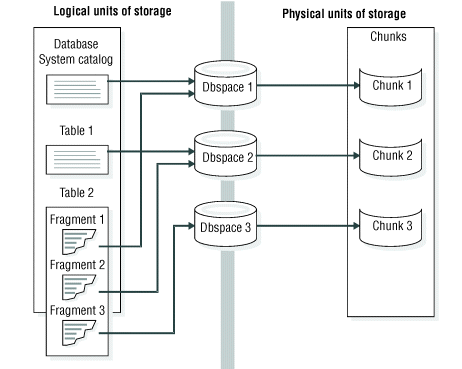Table fragmentation and data storage
The fragmentation feature gives you more control over where the database stores data. You are not limited to specifying the locations of individual tables and indexes. You can also specify the location of table and index fragments, which are different parts of a table or index that are on different storage spaces.
- Fragment a table over more than one dbspace. However, you cannot put fragments into dbspaces that have different page sizes. All fragments must have the same page size.
- Create multiple partitions of a fragmented table within a single dbspace if the fragmented table uses an expression-based or round-robin distribution scheme.
- Dbspaces
- Sbspaces
CREATE TABLE tablename ... FRAGMENT BY ROUND ROBIN IN dbspace1,
dbspace2, dbspace3;
CREATE TABLE tablename ...FRAGMENT BY EXPRESSION
<Expression 1> in dbspace1,
<Expression 2> in dbspace2,
<Expression 3> in dbspace3;The FRAGMENT BY ROUND ROBIN and FRAGMENT BY EXPRESSION keywords refer to two different distribution schemes. Both statements associate fragments with dbspaces.
If you set the AUTOLOCATE configuration parameter or session environment variable to a positive integer, and you do not specify a location for the table, new tables are fragmented in round-robin order in dbspaces that are chosen by the database server.
CREATE TABLE tb1(a int)
FRAGMENT BY EXPRESSION
PARTITION part1 (a >=0 AND a < 5) in dbs1,
PARTITION part2 (a >=5 AND a < 10) in dbs1
...
;